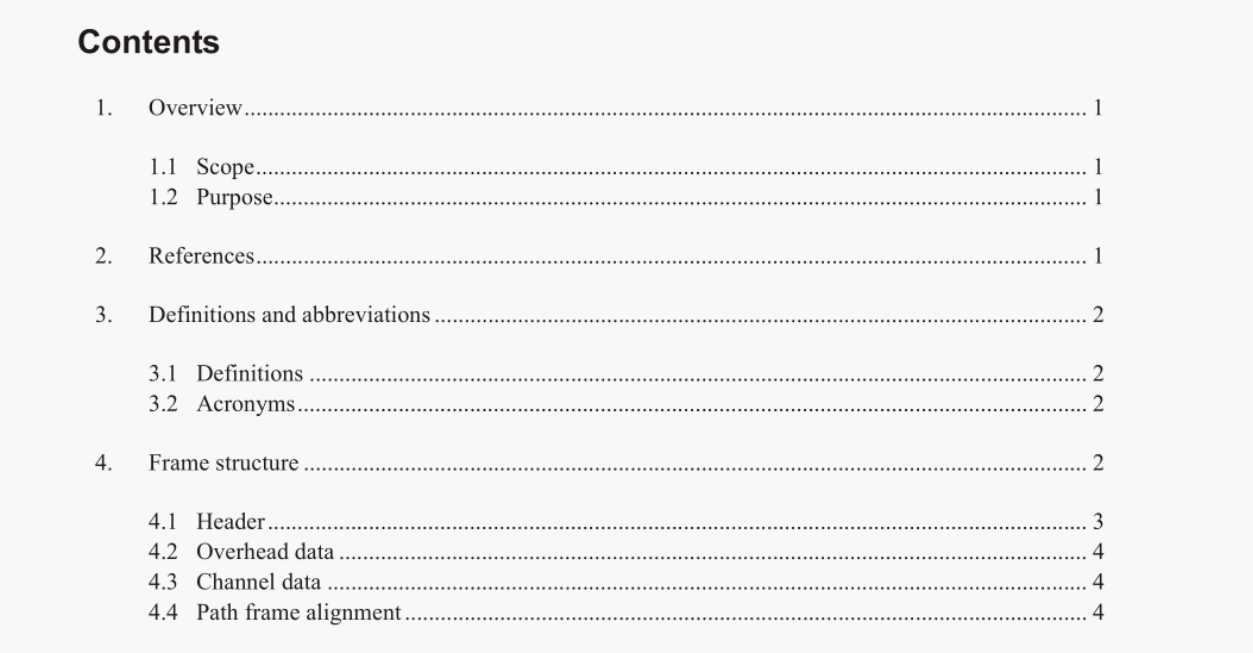BS IEC 62843-2013 pdf Standard for N times 64 kilobit per second optical fiber interfaces between teleprotection and multiplexer equipment

6. Clock timing The optical signal comprises a binary (on-off) modulation with a 2048 kilobit per second bit stream with the following timing requirements. 6.1 Frequency The frequency shall be 2048 kilobits per second +100 ppm. Each multiplexer end unit shall not use the signal from the teleprotection equipment for synchronization. Each teleprotection equipment end unit shall use the signal from the multiplexer unit for synchronization; upon LOS, the unit shall free-run with the above tolerance. Each multiplexer end unit shall be able to detect the overhead “yellow” bit correctly, even when the multiplexer end unit has lost synchronization (due to loss of optical input). For clarification, the above requires that a) The multiplexer unit normally receives data from the teleprotection equipment, at the same frequency as the multiplexer unit’s outgoing data, but during the failure of the outgoing fiber, the multiplexer unit must accept incoming data up to +100 ppm off frequency (detect framing, the overhead bits, and the data bits). It is acknowledged that being asynchronous to the multiplexer will cause bits to be lost, or filled (as in an asynchronous 64 kbit/s G703 interface), but this is considered preferable to squelching the data. b) The teleprotection equipment shall be able to receive signals with up to +100 ppm frequency tolerance on its optical input, and use this for the frequency of its outgoing signal to the multiplexer. If its input is bad, or lost, the teleprotection equipment shall use an internal reference with土100 ppm tolerance. 6.2 Jitter For the multiplexer unit output, the jtter shall be within +50 nanoseconds (+0.1 U). For the teleprotection equipment output, the jtter shall be within +100 nanoseconds (+0.2 UI). (This allows its clock recovery circuit to add +50 nanoseconds to the jitter it receives.)
The multiplexer unit’s receiver shall tolerate a jitter of +100 nanoseconds. For clarification, the above requires that if the data are observed on an oscilloscope triggered on either rising or falling transitions, the next transition should be at a minimum of 438 nanoseconds for the multiplexer unit output and a minimum of 388 to 438 nanoseconds for the teleprotection equipment output (depending on the jitter on its input data).
- ISO IEC 27050-4-2021 pdf Information technology — Electronic discovery — Part 4: Technical readiness
- ISO IEC 27036-1-2021 pdf Cybersecurity — Supplier relationships — Part 1: Overview and concepts
- ISO IEC 27013-2021 pdf Information security, cybersecurity and privacy protection — Guidance on the integrated implementation of ISO/IEC 27001 and ISO/IEC 20000-1
- ISO IEC 26580-2021 pdf Software and systems engineering — Methods and tools for the feature- based approach to software and systems product line engineering
- ISO IEC 24735-2021 pdf Information technology — Office equipment — Method for measuring digital copying productivity
- ISO IEC 24711-2021 pdf Information technology — Office equipment — Method for the determination of ink cartridge yield for colour inkjet printers and multi- function devices that contain printer components
- ISO IEC 23544-2021 pdf Information Technology — Data centres — Application Platform Energy Effectiveness (APEE)
- ISO IEC 23510-2021 pdf Information technology — 3D printing and scanning — Framework for an Additive Manufacturing Service Platform (AMSP)
- ISO IEC 23127-1-2021 pdf Information technology — Learning, education, and training — Metadata for facilitators of online learning — Part 1: Framework
- ISO IEC 23126-2021 pdf Information technology for learning, education and training — Ubiquitous learning resource organization and description framework
- IEC 62546-2009 pdf High Definition (HD) recording link guidelines
- IEC 62975-2021 pdf Natural esters – Guidelines for maintenance and use in electrical equipment
- IEC 60644-2009 pdf Specification for high-voltage fuse-links for motor circuit applications
- ISO IEC 27036-1-2021 pdf Cybersecurity — Supplier relationships — Part 1: Overview and concepts
- IEC 61472-2-2021 pdf Live working – Minimum approach distances – Part 2: Method of determination of the electrical component distance for AC systems from 1,0 kV to 72,5 kV
- BS ISO IEC 15420-2009 pdf Information technology一 Automatic identification and data capture techniques EAN/UPC bar code symbology specification
- BS ISO IEC 19762.5-2008 pdf Information technology一 Automatic identification and data capture (AIDC) techniques – Harmonized vocabulary Part 5: Locating systems
- BS IEC 60860-2014 pdf Radiation protection instrumentation一 Warning equipment for criticality accidents
- ISO IEC 24735-2021 pdf Information technology — Office equipment — Method for measuring digital copying productivity
- ISO IEC 24711-2021 pdf Information technology — Office equipment — Method for the determination of ink cartridge yield for colour inkjet printers and multi- function devices that contain printer components